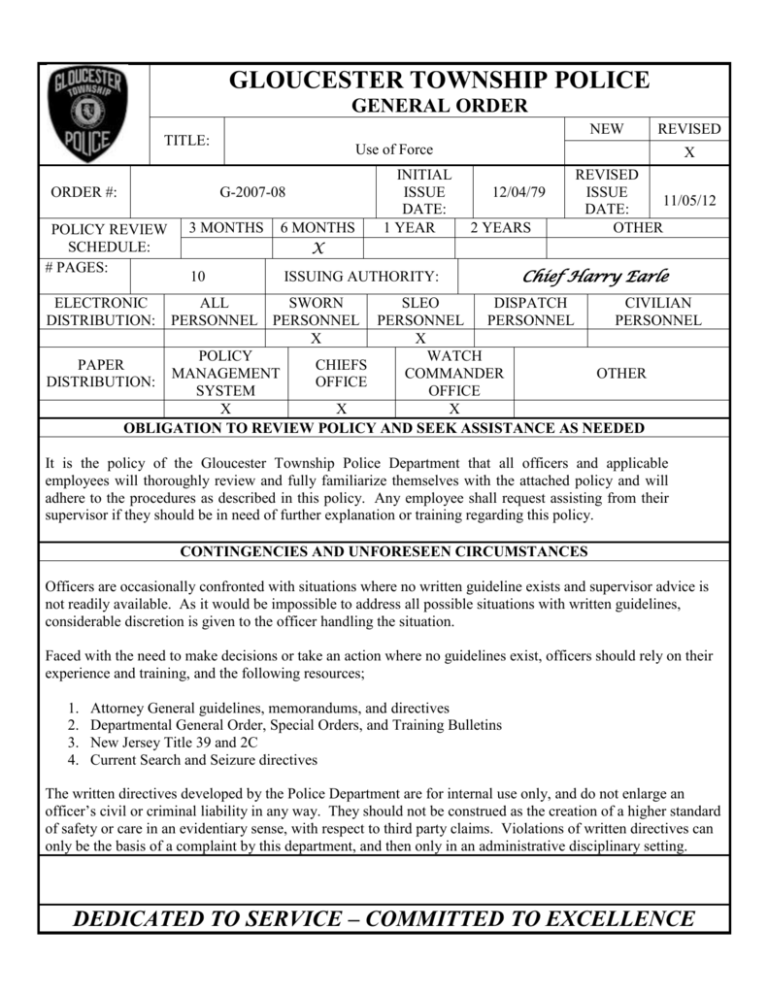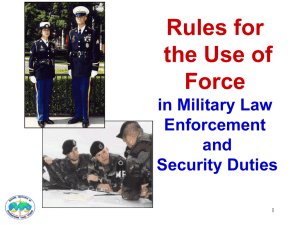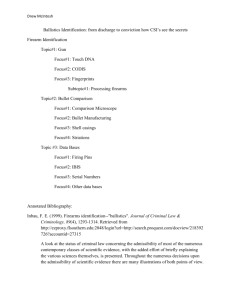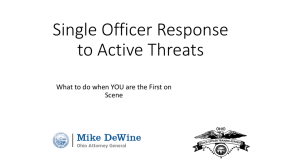gloucester township police general order
advertisement

GLOUCESTER TOWNSHIP POLICE GENERAL ORDER NEW TITLE: ORDER #: POLICY REVIEW SCHEDULE: # PAGES: REVISED Use of Force G-2007-08 INITIAL ISSUE DATE: 1 YEAR 3 MONTHS 6 MONTHS X 10 ISSUING AUTHORITY: X 12/04/79 2 YEARS REVISED ISSUE 11/05/12 DATE: OTHER Chief Harry Earle ELECTRONIC DISTRIBUTION: ALL SWORN SLEO DISPATCH CIVILIAN PERSONNEL PERSONNEL PERSONNEL PERSONNEL PERSONNEL X X POLICY WATCH PAPER CHIEFS MANAGEMENT COMMANDER OTHER DISTRIBUTION: OFFICE SYSTEM OFFICE X X X OBLIGATION TO REVIEW POLICY AND SEEK ASSISTANCE AS NEEDED It is the policy of the Gloucester Township Police Department that all officers and applicable employees will thoroughly review and fully familiarize themselves with the attached policy and will adhere to the procedures as described in this policy. Any employee shall request assisting from their supervisor if they should be in need of further explanation or training regarding this policy. CONTINGENCIES AND UNFORESEEN CIRCUMSTANCES Officers are occasionally confronted with situations where no written guideline exists and supervisor advice is not readily available. As it would be impossible to address all possible situations with written guidelines, considerable discretion is given to the officer handling the situation. Faced with the need to make decisions or take an action where no guidelines exist, officers should rely on their experience and training, and the following resources; 1. 2. 3. 4. Attorney General guidelines, memorandums, and directives Departmental General Order, Special Orders, and Training Bulletins New Jersey Title 39 and 2C Current Search and Seizure directives The written directives developed by the Police Department are for internal use only, and do not enlarge an officer’s civil or criminal liability in any way. They should not be construed as the creation of a higher standard of safety or care in an evidentiary sense, with respect to third party claims. Violations of written directives can only be the basis of a complaint by this department, and then only in an administrative disciplinary setting. DEDICATED TO SERVICE – COMMITTED TO EXCELLENCE I. PURPOSE The purpose of this general order is to bring the members and employees of this department into compliance with guidelines promulgated by the New Jersey Attorney General, Camden County Prosecutor and existing statutory and case law as they relate to the use of force by law enforcement officers. II. POLICY Sworn law enforcement officers have been granted the extraordinary authority to use force when necessary to accomplish lawful law enforcement objectives. That authority is grounded in the responsibility of every sworn law enforcement officer to comply with the laws of the State of New Jersey regarding the use of force and to comply with the provisions of this policy. Equally important is the obligation to prepare individual officers in the best way possible to exercise that authority. Each officer shall be guided by the principle that the degree of force employed in any situation should be only that which is reasonably necessary. The use of force should never be considered routine. It is the policy of the State of New Jersey, and this department, that officers will use only that force that is objectively reasonable and necessary. This general order reinforces the responsibility of officers to take those steps possible to prevent or stop the illegal or inappropriate use of force by other officers. Every law enforcement officer is expected and required to take appropriate action in any situation where that officer is clearly convinced that another officer is using force in violation of state law or this general order. Officers have a legal, moral and ethical obligation to report all situations in which force is used illegally by anyone. This policy sends a clear message to officers that they share an obligation beyond the requirements of law. Officers are encouraged to do whatever they can to interrupt the flow of events before a fellow officer does something illegal and before any official action is necessary. Officers can serve each other and the public by simply saying or doing the right thing to prevent a fellow officer from resorting to force illegally or inappropriately. Deciding to utilize force when authorized in the conduct of official responsibilities is among the most critical decisions made by officers. It is a decision that can be irrevocable. It is a decision that must be made quickly and under difficult, often unpredictable and unique circumstances. Sound judgment and the appropriate exercise of discretion will always be the foundation of police officer decision-making in the broad range of possible use of force situations. It is not possible to entirely replace judgment and discretion with detailed policy provisions. Nonetheless, this general order is intended to provide the best guidance and direction possible to officers when called upon to confront and address the most difficult of situations. Officers whose actions are consistent with the law and the provisions of this general order will be strongly supported by the law enforcement community in any subsequent review of their conduct regarding the use of force. Conversely, officers whose actions are contrary to law and the provisions of this general order may be subject to disciplinary action, up to and including criminal prosecution and/or termination. III. DEFINITIONS Constructive Authority Does not involve actual physical contact with a subject, but involves the use of the officer’s authority to exert control over a subject. Examples include verbal commands, gestures, warnings, and the un-holstering of a weapon. Pointing a firearm at a subject is an element of constructive authority to be used only in appropriate situations. For the purpose of this general order, pointing a firearm at a subject in appropriate situations shall be considered a threat of deadly force under constructive authority. Physical Contact Involves routine or procedural contact with a subject necessary to effectively accomplish a legitimate law enforcement objective. Examples include, guiding a subject into a police vehicle, holding the subject’s arm while transporting, handcuffing a subject and maneuvering or securing a subject for a frisk. Physical Force Involves contact with a subject beyond that which is generally utilized to affect an arrest or other law enforcement objective. Physical force is employed when necessary to overcome a subject’s physical resistance to the exertion of the officer’s authority, or to protect persons or property. Examples include, wrestling a resisting subject to the ground, using wrist locks or arm locks, striking with the hands or feet, or other similar methods of hand-to-hand confrontation. Mechanical Force Involves the use of some device or substance, other than a firearm, to overcome a subject’s resistance to the exertion of the officer’s authority. Examples include the use of a baton, or other object, canine physical contact with a subject, chemical munitions, Pepperball Launching System projectiles, or chemical or natural agent spraying. Enhanced Mechanical Force Is an intermediate force option between mechanical force and deadly force, requiring a greater level of justification than that pertaining to physical or mechanical force, but a lower level of justification than that required for the use of deadly force. Examples include the use of a conductive energy device (CED) or a firearm loaded with less lethal ammunition. A threat to use enhanced mechanical force, by production of a firearm dedicated for the use of less-lethal ammunition or a conductive energy device, or otherwise, so long as the officer’s purpose is limited to creating an apprehension that enhanced mechanical force will be used, if necessary, does not constitute enhanced mechanical force. Deadly Force Is force which an officer uses with the purpose of causing, or which the officer knows to create a substantial risk of causing, death or serious bodily harm. Purposely firing a firearm in the direction of another person or at a vehicle, building or structure in which another person is believed to be constitutes deadly force unless the firearm is loaded with less-lethal ammunition and fired by a law enforcement officer in the performance of the officer’s official duties. A threat to cause death or serious bodily harm, by the production of a weapon or otherwise, so long as the officer’s purpose is limited to creating an apprehension that deadly force will be used, if necessary, does not constitute deadly force. Reasonable Belief This is an objective assessment based upon an evaluation of how a reasonable police officer with comparable training and experience would react to, or draw inferences from, the facts and circumstances confronting and known by the officer at the scene. Law Enforcement Officer/Officer Any person sworn to enforce the criminal laws of the State of New Jersey, who is certified by the Police Training Commission, or is currently employed by a public safety agency and is authorized to carry a firearm under N.J.S.A. 2C:39-6. Imminent Danger This term describes threatened actions or outcomes that may occur during an encounter absent action by the officer. The period of time involved is dependent on the circumstances and facts evident in each situation and is not the same in all situations. The threatened harm does not have to be instantaneous. For example, imminent danger may be present even if a subject is not at that instant pointing a weapon at the officer, but is carrying a weapon and running for cover. Substantial Risk Any discharge of a firearm entails some risk of an unintended outcome. A substantial risk exists when an officer disregards a foreseeable likelihood that innocent persons will be endangered. For example, firing a weapon into a confined space (room, vehicle, etc.) occupied by innocent persons exposes those persons to a substantial risk of harm. Serious Bodily Injury This term means bodily injury, which creates a substantial risk of death or which causes serious, permanent disfigurement, or protracted loss or impairment of the function of any bodily member or organ. Less-Lethal Ammunition This term means ammunition approved by the Attorney General which is designed to stun, temporarily incapacitate or cause temporary discomfort to a person without penetrating the person’s body. The term shall also include ammunition approved by the Attorney General which is designed to gain access to a building or structure and is used for that purpose. Conductive Energy Device This term means any device approved by the Attorney General that is capable of firing darts/electrodes that transmit an electrical charge or current intended to temporarily disable a person. IV. AUTHORIZATION AND LIMITATIONS A. Use of Force 1. An officer may use physical force or mechanical force when the officer reasonably believes it is immediately necessary at the time: a) To overcome resistance directed at the officer or others; or b) To protect the officer or a third party from unlawful force; or c) To protect property; or d) To affect other lawful objectives, such as make an arrest. B. Enhanced Mechanical Force The Gloucester Township Police Department has authorized the use of conducted energy devices for an authorized officer and in compliance with the Revised Attorney General Policy on Conducted Energy Devices approved and effective on October 7, 2010, the authorization of the Camden County Prosecutor, and Gloucester Township Police Department General Order G-2012-18 titled “Conducted Energy Devices”. C. Use of Deadly Force 1. An officer may use deadly force when the officer reasonably believes such action is immediately necessary to protect the officer or another person from imminent danger of death or serious bodily harm. 2. An officer may use deadly force to prevent the escape of a fleeing suspect: a) Whom the officer has probable cause to believe has committed an offense that the suspect caused or attempted to cause death or serious bodily harm; and b) Who will pose an imminent danger of death or serious bodily harm should the escape succeed; and c) When the use of deadly force presents no substantial risk of injury to innocent persons. 3. If feasible, officers should identify themselves and state their intention to shoot before using a firearm. D. Restrictions on the Use of Deadly Force 1. An officer is under no obligation to retreat or desist when resistance is encountered or threatened. However, an officer shall not resort to the use of deadly force if an officer reasonably believes that an alternative to the use of deadly force will avert or eliminate an imminent danger of death or serious bodily harm and achieve the law enforcement purpose at no increased risk to the officer or another person. 2. An officer shall not use deadly force to subdue persons whose actions are only destructive to property. 3. Deadly force shall not be used against persons whose conduct is injurious only to them. 4. An officer shall not discharge a weapon as a signal for help or as a warning. 5. While any discharge of a firearm entails some risk, discharging a firearm at or from a moving vehicle entails an even greater risk of death or serious injury to innocent persons. The safety of innocent people is jeopardized when a fleeing suspect is disabled and loses control of their vehicle. There is also a substantial risk of harm to occupants of the suspect vehicle who may not be involved, or involved to a lesser extent, in the actions that necessitated the use of deadly force. 6. Due to this greater risk, and considering that firearms are not generally effective in bringing moving vehicles to a rapid halt, officers shall not fire from a moving vehicle or at the driver or occupant of a moving vehicle unless the officer reasonably believes: a. There exists an imminent danger of death or serious bodily harm to the officer or another person; and b. No other means are available at that time to avert or eliminate the danger. 7. Officers shall not fire a weapon solely to disable moving vehicles. E. Exhibiting a Firearm An officer shall not unholster or exhibit a firearm except under any of the following circumstances: 1. For maintenance of the firearm; 2. To secure the firearm; 3. During training exercises, practice or qualification with the firearm; 4. When circumstances create a reasonable belief that it may be necessary for the officer to use the firearm; 5. When circumstances create a reasonable belief that the display of a firearm as an element of constructive authority helps establish or maintain control in a potentially dangerous situation in an effort to discourage resistance and ensure officer safety; 6. When ordered or authorized by a supervisor or other lawful authority. V. TRAINING REQUIREMENTS This department will conduct and document semi-annual training for all officers on the lawful and appropriate use of force and deadly force. This training will be designed to reflect current standards established by statutory and case law, as well as state, county and departmental written directives and guidelines. The training program will include the use of force in general, the use of physical and mechanical force, the use of enhanced mechanical force, the use of deadly force, decision making skills and the limitations that govern the use of force, deadly force and reporting requirements. The use of force training will be conducted semi-annually during in service training. VI. USE OF FORCE REPORTS A. In all instances when physical force, mechanical force, enhanced mechanical, or deadly force is used, each member or employee who has employed such force shall complete and submit: 1. Incident or Supplemental report, or any other report that is necessary in compliance with this or any other Departmental Order (OC, CED, Firearms discharge, etc.) 2. A Use of Force Report GTPD Form 133 (Appendix A) B. A written report must be submitted whenever a member or employee takes an action that results in, or is alleged to have resulted in, injury or death of another person. C. The Watch Commander / Unit Supervisor shall review the Use of Force Report for accuracy and completeness and shall promptly address any issues as they may pertain to policy changes, training, weapons or equipment, or discipline. Recommendations shall be forwarded through the designated chain of command. If a Use of Force Report is completed by a Platoon Commander or a Bureau Supervisor, the officer’s Division Commander shall review the report as prescribed in the above paragraph. If a Division Commander completes a Use of Force Report, the Deputy Chief of Police shall review the report as prescribed in the above paragraph. If the Deputy Chief of Police completes a Use of Force Report, the Chief of Police shall review the report as prescribed in the above paragraph. If the Chief of Police completes a Use of Force Report, the Deputy Chief of Police shall review the report as prescribed in the above paragraph. D. After the appropriate supervisor has reviewed the Use of Force Report, it is then clear to be forwarded to the Police Records Unit. A copy of the Use of Force Report shall be forwarded to the Professional Standards Bureau to conduct an administrative review of each incident. . E. The original Use of Force Report shall be forwarded to the Police Records Unit, where it shall be stored in a file separate from the incident report. The Professional Standards Bureau shall review these reports monthly to assess any trends or issues that need to be studied, analyzed, and/or addressed. F. The Professional Standards Bureau shall be responsible for completing the annual Use of Force Summary Report in a manner prescribed by the Camden County Prosecutor. This report shall be forwarded to the Camden County Prosecutor’s Office, through the Chief of Police upon completion by January 15 of the following calendar year. G. In all instances where constructive authority results in the pointing of a firearm at another person, the facts and circumstances shall be reported on an Incident Report and a Use of Force Report. In a case where more than one officer points their firearm at an individual(s) under Constructive Authority during an investigation, each officer shall complete a Use of Force form to be submitted with one incident report documenting the nature of the incident. VII. USE OF FORCE PROFESSIONAL STANDARDS REVIEW A. All use of force incidents are subject to an administrative professional standards review utilizing an Administration Review Form GTPD Form 190 (Appendix B). The review shall ordinarily involve a review of all documents, available evidence and an interview of any available persons who may have information regarding the incident. B. The purpose of the administrative review is to determine if the actions taken during the use of force incident comply with statutory law, current criminal procedure, Attorney General’s Guidelines, Prosecutor’s Guidelines and this general order. Further purposes are to identify the need for an internal affairs investigation, training needs, and to determine if modifications to this general order are required or recommended. If the administrative review reveals that the officer’s actions require an internal affairs investigation, the Chief of Police shall be notified via the Chain of Command. C. Although there is no strict time limitation for the submission of the administrative review, the final report should be completed without undue delay. Depending on the scope of the review, three to five working days should be considered adequate to complete the investigation. The Chief of Police may cause further review of the incident. VIII. RENDERING MEDICAL AID If the use of force results in an injury to any party, prompt medical attention shall be offered and/or provided as soon as it is safe for officers to do so. Medical attention shall include but is not limited to: increased visual observation by the officer to detect obvious changes in the subject’s condition, flushing chemical agents from the eyes, applying first aid, or immediate attention by medical personnel. The attention by medical personnel may consist of treatment / evaluation at the scene or at a medical facility. The extent of the injury and the treatment offered shall be documented in the body of the investigation report. IX. NOTIFICATIONS / REVIEW In the event an officer has used physical force, mechanical force, enhanced mechanical force, deadly force, or when they point their firearm at an individual(s) under constructive authority whether on or off duty, the officer must notify the on duty Watch Commander. The Watch Commander shall ensure that the Chief of Police and the Camden County Prosecutor’s Office are immediately notified when the use of physical force, mechanical force, enhanced mechanical force, or deadly force results in death or serious bodily injury, or when injury of any degree results from the use of a firearm by an officer. The Chief of Police shall be notified through the Chain of Command. Members or employees whose actions or use of force results in a death or serious injury to any other person shall be removed from a line duty assignment and assigned to an administrative duties detail pending administrative review of the facts and circumstances of the incident. The member or employee shall also be offered critical incident stress debriefing as per General Order G-2012-07 titled Employee Assistance Program and Critical Incident Stress Management. APPENDIX A APPENDIX B






